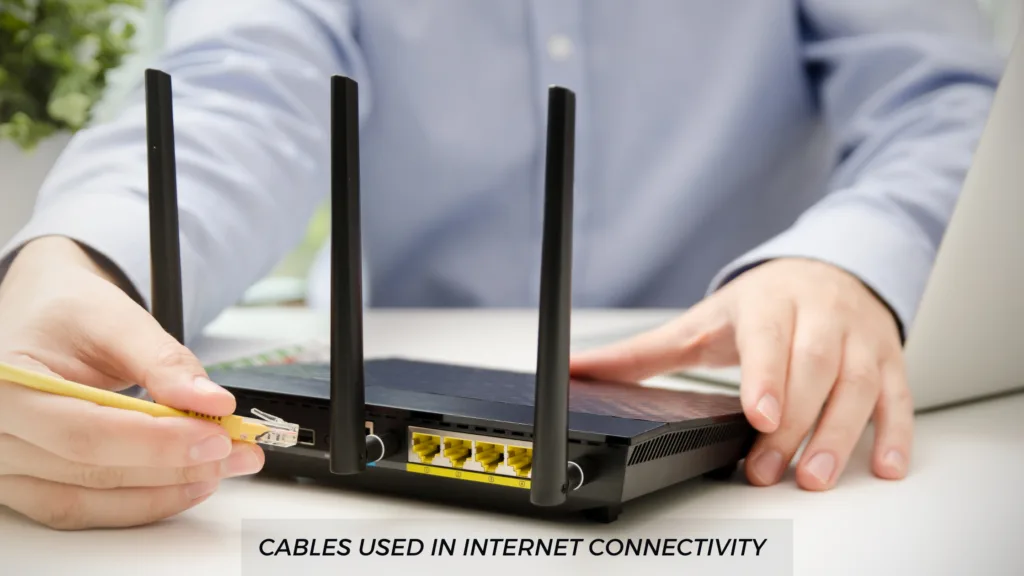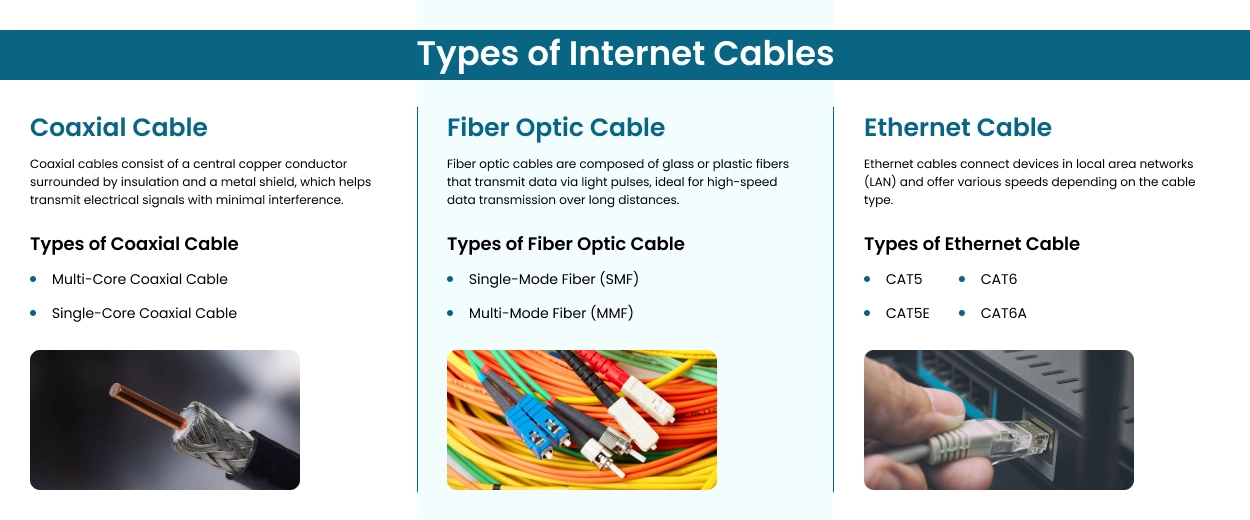"*" indicates required fields

A dependable and fast internet connection is necessary for personal and business use in a networked environment. The kind of cable you use for internet connectivity is crucial, regardless of whether you’re managing a business network, working from home, or streaming films. The Internet infrastructure uses a variety of cables, each constructed to satisfy particular demands on distance, speed, and dependability. This blog will examine the features, benefits, and best practices of the various types of cables used in Internet connectivity.
Cables are the foundational elements of Internet connectivity, providing the physical means to transmit data between devices and networks. They play a crucial role in ensuring that digital information can travel quickly and accurately from one point to another, facilitating everything from simple web browsing to complex data transactions in large enterprises. Without the appropriate cabling, even the most advanced internet technologies would struggle to deliver the high-speed, reliable connections that users expect.
The types of cables used for internet connectivity vary widely, each designed to meet specific requirements. Some cables are optimized for long-distance data transmission, while others are built to handle high-speed data transfer within shorter ranges. The materials used in these cables, such as copper or fiber optics, also significantly impact their performance, durability, and suitability for different environments. Understanding these differences is critical to selecting the right cable for any application.
Internet Service Providers (ISPs) are the companies responsible for delivering Internet access to consumers and businesses. They play a vital role in determining the quality and speed of internet connections by managing the infrastructure that connects users to the internet. ISPs use a variety of cables to deliver their services, often depending on the geographic region, existing infrastructure, and the specific needs of their customers. Understanding the types of wires ISPs use can help consumers make informed decisions about their internet service.
ISPs typically choose between coaxial cables, fiber optic cables, and sometimes, DSL (Digital Subscriber Line) cables based on their service plans and the infrastructure available. Coaxial cables, for example, are commonly used for residential internet services because they are robust and capable of handling high-frequency signals over medium distances. Fiber optic cables, on the other hand, are increasingly used for their unmatched speed and reliability, particularly in urban areas where high-speed internet is in high demand.

Coaxial cable, often referred to simply as coax, is a type of electrical cable consisting of a central conductor surrounded by an insulating layer, a metallic shield, and an outer insulating layer. This design allows coaxial cables to carry high-frequency signals with minimal electromagnetic interference, making them popular for various applications, including cable television and internet services. The durability and robustness of coaxial cables make them suitable for indoor and outdoor installations.
Durability: Coaxial cables are highly durable and can withstand physical stress, making them ideal for outdoor and indoor installations.
High Bandwidth: They offer substantial bandwidth and can support broadband internet speeds.
Wide Availability: Coaxial cables are widely available and used in existing infrastructure, making them a cost-effective solution for many ISPs.
Coaxial cables are typically used for residential internet services, cable TV connections, and, in some instances, business internet solutions where fiber optic infrastructure is not available.
Fiber optic cable uses light to transmit data, offering significantly higher speeds and greater reliability compared to traditional copper cables. These cables consist of thin glass or plastic fibers that carry light signals over long distances with minimal signal loss. The core of each fiber optic cable is designed to transmit light, while the surrounding layers help protect the signal from interference and physical damage.
Unmatched Speed: Fiber optic cables offer the highest internet speeds, often exceeding 1 Gbps.
Long-Distance Transmission: They can transmit data over longer distances without significant signal degradation.
Interference-Free: Fiber optics are immune to electromagnetic interference, ensuring a stable connection.
Coaxial cables are typically used for residential internet services, connecting homes to the broader internet infrastructure. They are also commonly used for cable television connections, leveraging their ability to carry high-frequency signals. In some cases, businesses may also use coaxial cables for internet services, particularly in areas where fiber optic infrastructure is not yet available. The versatility and reliability of coaxial cables make them a practical choice for a wide range of applications.
Ethernet cables, also known as network cables, connect devices within a local area network (LAN). They come in various categories, each offering different performance levels.
CAT5: Suitable for basic networking needs, supporting speeds up to 100 Mbps.
CAT5E: An enhanced version of CAT5, supporting speeds up to 1 Gbps.
CAT6: Offers speeds up to 10 Gbps over short distances, with better performance and reduced crosstalk.
CAT6A: An augmented version of CAT6, supporting 10 Gbps over longer distances up to 100 meters.
Fiber optic cables are ideal for high-speed internet services, providing the backbone for many modern telecommunications networks. They are widely used in enterprise networks, data centers, and other environments where high-speed, reliable data transmission is critical. Fiber optic technology is also increasingly being deployed in residential areas, offering consumers ultra-fast internet speeds that are essential for bandwidth-intensive activities such as streaming, gaming, and remote work.
CAT5 cables are older, and support speeds up to 100 Mbps with a bandwidth of 100 MHz. They are suitable for basic networking tasks but are becoming outdated due to their limited speed capabilities.
CAT5E, or Category 5 Enhanced, offers improved performance over CAT5. It supports speeds up to 1 Gbps with a bandwidth of 100 MHz and reduced crosstalk, making it a more reliable choice for modern networks.
While CAT5 might suffice for fundamental and small-scale networking, CAT5E is the preferred choice for most users due to its superior speed and reliability.
CAT6 cables support speeds up to 10 Gbps over short distances (up to 55 meters) and have a bandwidth of 250 MHz. They are suitable for high-speed applications and are commonly used in residential and commercial settings.
CAT6A, or Category 6 Augmented, offers enhanced performance. It supports 10 Gbps speeds over longer distances up to 100 meters and a bandwidth of 500 MHz. It is ideal for environments requiring high data throughput and minimal interference.
CAT6 is sufficient for most high-speed networking, but CAT6A is the better choice for installations requiring longer cable runs and maximum performance.
Professional cabling services ensure your network can handle multiple databases efficiently, reducing downtime and improving data accessibility.
High-quality cabling installed by professionals guarantees faster and more reliable internet connections, which are crucial for business operations.
Professionals can update and optimize your network switches, ensuring they are compatible with the latest cabling standards and can handle increased data loads.
Choosing the correct type is essential as the cable is used for the Internet. Professional cabling services can recommend and install the most suitable wires for your network requirements.
Modern businesses rely on IP phones for communication. Professional cabling ensures your network can support these devices without issues, providing clear and reliable voice communication.
Unlock the full potential of your network with Network Drops. Our expert technicians specialize in designing and installing customized cabling solutions tailored to meet the unique demands of your business. Whether upgrading your current infrastructure, installing network drops, or optimizing your data center, we provide top-tier services that ensure seamless connectivity, high-speed performance, and reliable communication across all your devices. Don’t let outdated cabling slow down your productivity. Contact Network Drops today for a consultation and discover how our professional cabling services can transform your network and drive your business forward.
The type of cable you need depends on your specific requirements. Fiber optic cables are the best choice for high-speed internet. CAT5E or CAT6 cables are recommended for local area networks. Coaxial cables are suitable for basic residential internet services.
The best Ethernet cable depends on your needs. CAT5E is sufficient for general use. For higher speeds and better performance, CAT6 or CAT6A cables are recommended.
No, an Ethernet cable connects two devices. To connect multiple devices, you will need a network switch or router.
The cost of structured cabling varies based on the size of the installation, the type of cables used, and the complexity of the network design. It’s best to get a quote from professional cabling services.
Professional cabling technicians typically have extensive training and experience installing and maintaining network cabling. They know the latest standards and technologies, ensuring your network is optimized for optimal performance.
Scott Fcasni is the driving force behind Shock I.T. Support’s commercial datacomm cabling division, delivering expert solutions that power reliable, high-performance network infrastructures. With extensive experience in structured cabling and a commitment to precision, Scott ensures that every project—whether for small businesses or large enterprises—meets the highest standards of quality and scalability.